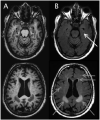Antiphospholipid antibodies, brain infarcts, and cognitive and motor decline in aging (ABICMA): design of a community-based, longitudinal, clinical-pathological study
- PMID: 23095514
- PMCID: PMC3638838
- DOI: 10.1159/000342761
Antiphospholipid antibodies, brain infarcts, and cognitive and motor decline in aging (ABICMA): design of a community-based, longitudinal, clinical-pathological study
Abstract
The overall goal of the Antiphospholipid Antibodies, Brain Infarcts, and Cognitive and Motor Decline in Aging study is to test the hypothesis that antiphospholipid antibodies (aPL) are associated with an increased risk of pathologically proven brain infarcts and are related to cognitive and motor decline in aging. Putative biologic mechanisms underlying the association of aPL with infarcts and the relation of aPL with clinical outcomes of cognitive and motor impairment, including vascular and other processes, will be examined. The design of this longitudinal, clinical-pathologic study involves quantifying four aPL assays, and relating these to brain infarcts, and to cognitive and motor decline. Vascular mechanisms assessed using antemortem magnetic resonance neuroimaging and postmortem neuropathology, as well as nonvascular mechanisms of inflammation and blood-brain barrier permeability alterations will be examined as plausible mediators of the relation of aPL to cognitive and motor impairment. We will take advantage of antemortem biological specimens (longitudinally collected sera and plasma from which aPL, annexins, C-reactive protein, and matrix metalloproteinases will be quantified), and clinical, neuroimaging, and postmortem neuropathologic data from about 800 elderly, community-dwelling women and men who have agreed to brain autopsy at the time of death, participating in one of two ongoing studies of aging: the Religious Orders Study and the Memory and Aging Project.
Copyright © 2012 S. Karger AG, Basel.
Figures






Similar articles
-
Relation of antiphospholipid antibodies to postmortem brain infarcts in older people.Circulation. 2015 Jan 13;131(2):182-9. doi: 10.1161/CIRCULATIONAHA.114.012479. Epub 2014 Oct 9. Circulation. 2015. PMID: 25301832 Free PMC article.
-
Antiphospholipid Antibodies: Cognitive and Motor Decline, Neuroimaging and Neuropathology.Neuroepidemiology. 2019;53(1-2):100-107. doi: 10.1159/000500157. Epub 2019 May 8. Neuroepidemiology. 2019. PMID: 31067547 Free PMC article.
-
Neuropathologic and Cognitive Correlates of Enlarged Perivascular Spaces in a Community-Based Cohort of Older Adults.Stroke. 2020 Sep;51(9):2825-2833. doi: 10.1161/STROKEAHA.120.029388. Epub 2020 Aug 6. Stroke. 2020. PMID: 32757750 Free PMC article.
-
Relationship of Antiphospholipid Antibodies to Risk of Dementia: A Systematic Review.J Alzheimers Dis. 2019;69(2):561-576. doi: 10.3233/JAD-181294. J Alzheimers Dis. 2019. PMID: 31104025
-
Selected findings from the Religious Orders Study and Rush Memory and Aging Project.J Alzheimers Dis. 2013;33 Suppl 1(0):S397-403. doi: 10.3233/JAD-2012-129007. J Alzheimers Dis. 2013. PMID: 22647261 Free PMC article. Review.
Cited by
-
Presence of Anticardiolipin Antibodies in Patients with Dementia: A Systematic Review and Meta-Analysis.Front Aging Neurosci. 2017 Aug 2;9:250. doi: 10.3389/fnagi.2017.00250. eCollection 2017. Front Aging Neurosci. 2017. PMID: 28824414 Free PMC article.
-
Cognitive Impairment in Anti-Phospholipid Syndrome and Anti-Phospholipid Antibody Carriers.Brain Sci. 2022 Feb 5;12(2):222. doi: 10.3390/brainsci12020222. Brain Sci. 2022. PMID: 35203985 Free PMC article. Review.
-
Relation of antiphospholipid antibodies to postmortem brain infarcts in older people.Circulation. 2015 Jan 13;131(2):182-9. doi: 10.1161/CIRCULATIONAHA.114.012479. Epub 2014 Oct 9. Circulation. 2015. PMID: 25301832 Free PMC article.
-
Antiphospholipid Antibodies: Cognitive and Motor Decline, Neuroimaging and Neuropathology.Neuroepidemiology. 2019;53(1-2):100-107. doi: 10.1159/000500157. Epub 2019 May 8. Neuroepidemiology. 2019. PMID: 31067547 Free PMC article.
References
-
- Ginsburg KS, Liang MH, Newcomer L, Goldhaber SZ, Schur PH, Hennekens CH, Stampfer MJ. Anticardiolipin antibodies and the risk for ischemic stroke and venous thrombosis. Ann Intern Med. 1992;117:997–1002. - PubMed
-
- Brey RL, Abbott RD, Curb JD, Sharp DS, Ross GW, Stallworth CL, Kittner SJ. Beta(2)-Glycoprotein 1-dependent anticardiolipin antibodies and risk of ischemic stroke and myocardial infarction: the Honolulu Heart Program. Stroke. 2001;32:1701–1706. - PubMed
-
- Janardhan V, Wolf PA, Kase CS, Massaro JM, D’Agostino RB, Franzblau C, Wilson PWF. Anticardiolipin antibodies and risk of ischemic stroke and transient ischemic attack. The Framingham Cohort and Offspring Study. Stroke. 2004;35:736–741. - PubMed
-
- Rand JH, Wu XX, Andree HA, Lockwood CJ, Guller S, Scher J, Harpel PC. Pregnancy loss in the antiphospholipid-antibody syndrome--a possible thrombogenic mechanism. NEJM. 1997 Jul 17;337(3):154–160. - PubMed
-
- McLaurin EY, Holliday SL, Williams P, Brey RL. Predictors of cognitive dysfunction in patients with systemic lupus erythematosus. Neurology. 2005;64(2):297–303. - PubMed
Publication types
MeSH terms
Substances
Grants and funding
LinkOut - more resources
Full Text Sources
Other Literature Sources
Medical
Research Materials

